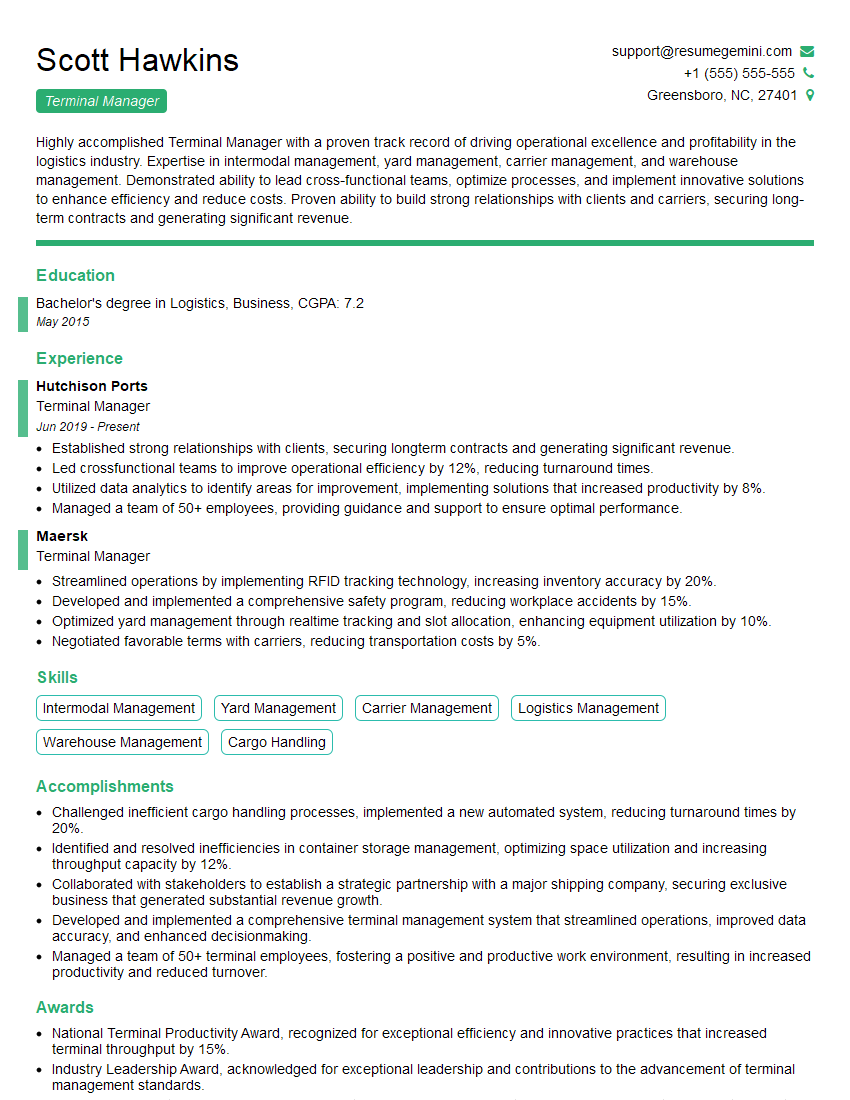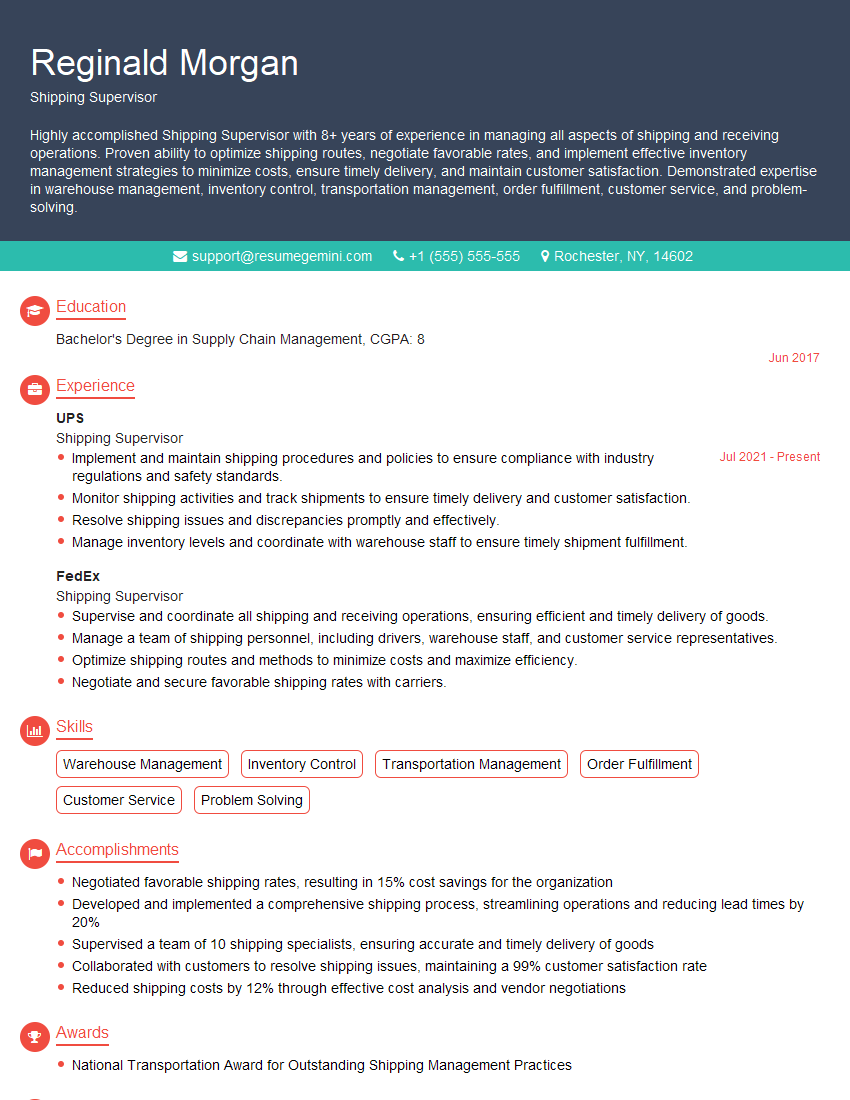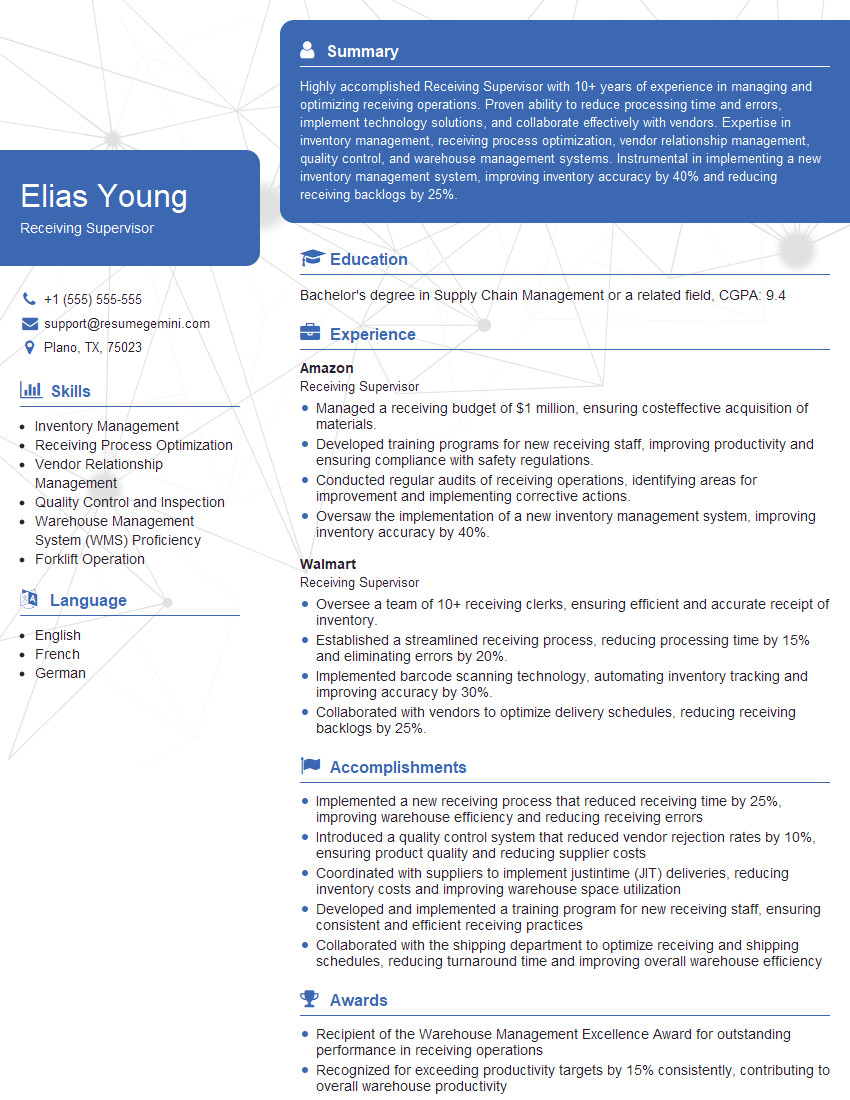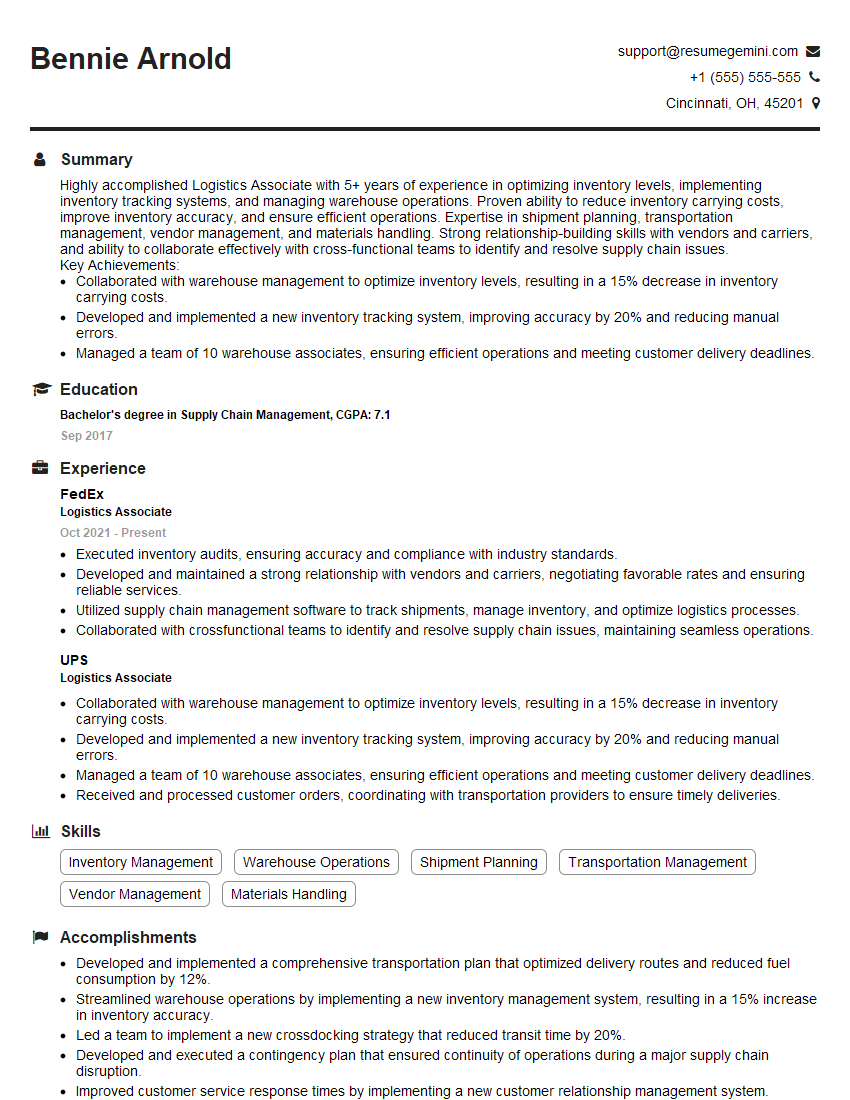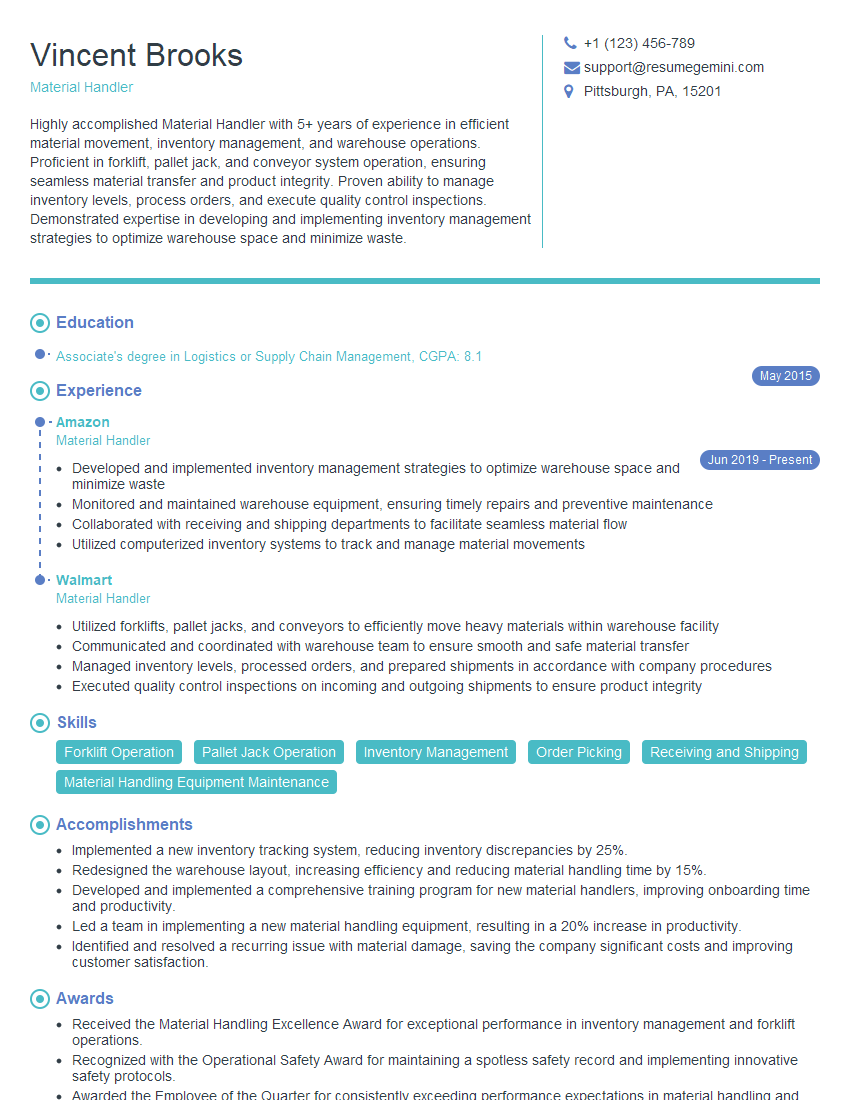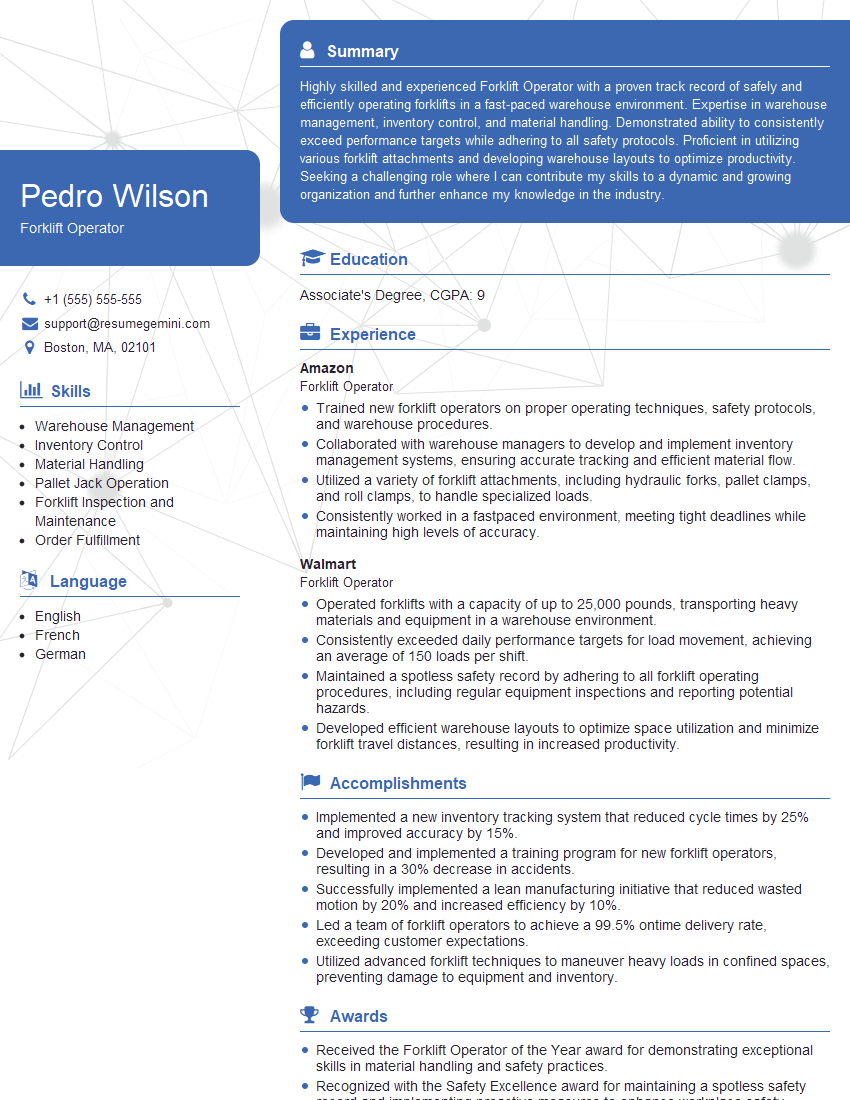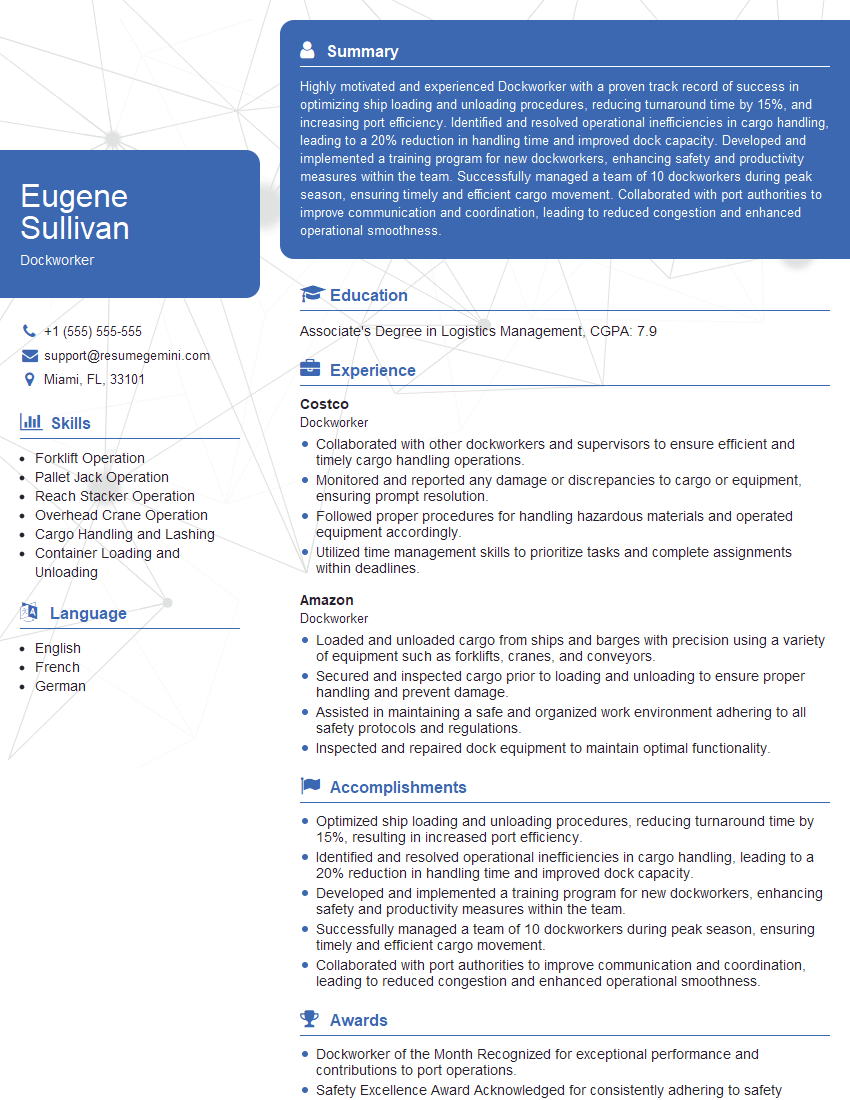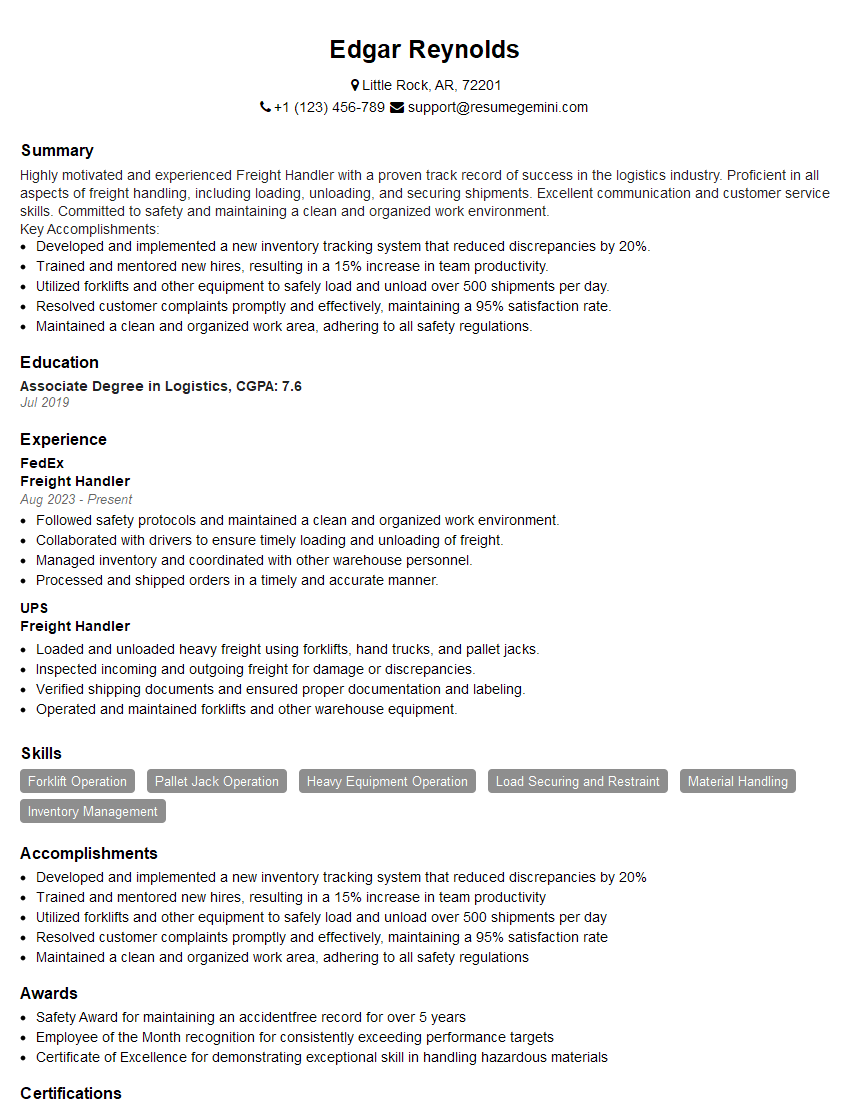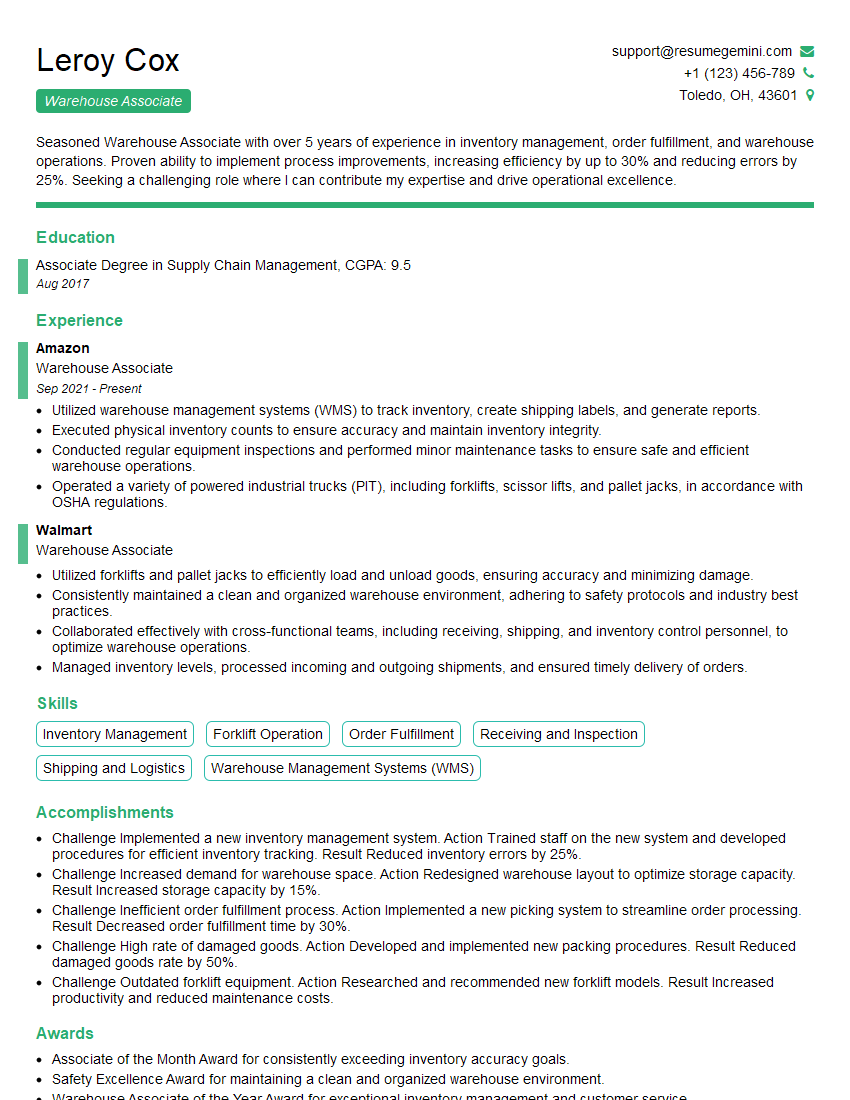Unlock your full potential by mastering the most common Container Loading/Unloading interview questions. This blog offers a deep dive into the critical topics, ensuring you’re not only prepared to answer but to excel. With these insights, you’ll approach your interview with clarity and confidence.
Questions Asked in Container Loading/Unloading Interview
Q 1. Describe your experience with different types of containers (e.g., 20ft, 40ft, refrigerated).
My experience encompasses a wide range of container types, from standard 20-foot and 40-foot containers to specialized units like refrigerated (reefer) containers, high-cube containers offering increased height, and open-top containers for oversized cargo. I’m proficient in handling the specific loading and unloading procedures for each. For example, with reefer containers, I understand the importance of pre-trip inspections to ensure the refrigeration unit is functioning correctly and the temperature is set according to the cargo’s requirements. Similarly, loading oversized cargo into an open-top container requires careful planning and execution to ensure stability and prevent damage.
Working with 20-foot containers often involves smaller, lighter shipments, while 40-foot containers are more suitable for larger, heavier loads. This difference impacts equipment selection and load planning. My experience includes efficient handling of various container sizes and types, ensuring optimized space utilization and preventing any damage.
Q 2. Explain the process of securing cargo within a container to prevent damage during transit.
Securing cargo is paramount to prevent shifting and damage during transit. The process starts with a thorough assessment of the cargo’s characteristics – weight, dimensions, fragility, and any special handling requirements. We then choose appropriate securing methods, such as:
- Dunnage: Using wood, cardboard, or other materials to fill empty spaces and prevent shifting.
- Strapping: Applying steel or plastic straps to bind cargo together tightly.
- Blocking and bracing: Using wooden blocks and bracing to prevent movement and support heavier items.
- Shock absorption materials: Employing bubble wrap, foam, or other materials to protect fragile items from impact.
The specific method depends on the cargo. For example, fragile electronics might require extensive cushioning and bracing, while heavy machinery may need robust steel strapping and blocking. Proper documentation of the securing process is vital, including diagrams and notes, for insurance and traceability purposes.
Q 3. What safety measures do you follow when loading/unloading containers?
Safety is always my top priority. My safety procedures include:
- Pre-operation checks: Inspecting the container, loading equipment (forklifts, cranes), and surrounding area for hazards before starting.
- Personal Protective Equipment (PPE): Always wearing appropriate PPE, including safety helmets, high-visibility vests, safety shoes, and gloves.
- Safe lifting techniques: Following correct procedures for lifting and moving heavy items to prevent injury.
- Communication: Maintaining clear communication with the team to coordinate movements and avoid accidents.
- Emergency procedures: Understanding and being prepared for emergency situations, including knowing the location of fire extinguishers and emergency contacts.
- Load stability checks: Regularly checking the stability of the load during loading and unloading to prevent collapses.
I’ve developed a keen awareness of potential hazards, such as uneven ground, damaged equipment, and unpredictable weather conditions. Proactive risk mitigation is key to preventing accidents.
Q 4. How do you ensure the weight distribution is balanced within a container?
Weight distribution is critical for container stability and safe transportation. Uneven weight distribution can lead to container instability and potential damage to the cargo during transit. I ensure balanced weight distribution by:
- Detailed planning: Creating a load plan that considers the weight and dimensions of each item.
- Strategic placement: Positioning heavier items lower and closer to the container floor, and distributing weight evenly across the container.
- Weight calculations: Utilizing weight scales and load calculation tools to accurately determine the weight of each item and the overall weight distribution.
- Regular checks: Visually inspecting the load throughout the process to verify that the weight is evenly distributed.
Imagine stacking books on a shelf; you wouldn’t put all the heavy books on one side. The same principle applies to container loading. A well-balanced load minimizes the risk of damage during transport.
Q 5. What are the common challenges you face during container loading/unloading?
Common challenges include:
- Improper cargo securing: Dealing with cargo that has been inadequately secured by the shipper, requiring additional measures on-site.
- Damaged or defective containers: Encountering containers with structural damage or issues with doors or seals.
- Time constraints: Working under pressure to meet tight deadlines and schedules, impacting the quality of work if not managed efficiently.
- Weather conditions: Adverse weather, such as rain or strong winds, can hinder loading/unloading operations and increase safety risks.
- Space constraints: Limited space at the loading dock can make maneuvering equipment and containers difficult.
- Inconsistent cargo information: Receiving inaccurate or incomplete information about the cargo’s dimensions and weight can lead to complications during loading.
Overcoming these challenges requires problem-solving skills, adaptability, and effective communication to find efficient solutions while adhering to safety regulations.
Q 6. Describe your experience with using various loading equipment (e.g., forklifts, cranes).
I’m experienced with various loading equipment, including forklifts, reach stackers, and overhead cranes. My experience spans different forklift types – counterbalance, reach, and sideloaders – each suited for specific tasks. For instance, a reach stacker is ideal for stacking containers, while a sideloader is better for narrow spaces. Overhead cranes are crucial for loading and unloading exceptionally heavy items or those requiring precision placement. I am also familiar with the safety regulations and operating procedures associated with each type of equipment.
I understand the limitations of each piece of equipment and select the appropriate one based on the job’s demands. Safety training and certification ensure I operate these machines safely and effectively, adhering to all relevant regulations and best practices.
Q 7. How do you handle damaged or defective containers?
Damaged or defective containers require immediate attention. The first step is a thorough inspection to identify the extent of the damage. Minor damage might only require extra caution during loading to avoid exacerbating the issue, while significant damage could lead to rejection of the container. If the damage compromises the structural integrity of the container, I would immediately report it to the supervisor and initiate a process to replace the container with a sound one. Documentation, including photos and detailed descriptions, is essential to support any claims related to the damage.
Safety is paramount. Loading into a damaged container might be unsafe; therefore, the decision to proceed is made based on a risk assessment, and prioritizes the safety of personnel and the integrity of the cargo.
Q 8. What is your experience with inventory management related to container loading/unloading?
Inventory management in container loading/unloading is crucial for efficiency and accuracy. It involves meticulously tracking the quantity, type, and location of all cargo within a container and throughout the entire logistics process. This begins before the container even arrives. I leverage Warehouse Management Systems (WMS) and other inventory software to create precise loading plans, ensuring that items are easily accessible during unloading and that space within the container is maximized. For example, in one project involving the shipment of fragile electronics, I utilized a WMS to create a detailed inventory list, allocating specific locations within the container based on weight, fragility, and dimensions. This minimized the risk of damage during transit.
Post-loading, I use scanners to verify that the loaded items match the manifest, then continuously update the inventory system reflecting the movement of goods – from the yard to the vessel and during the final unloading. This real-time tracking allows for immediate identification of discrepancies and facilitates timely resolution of any issues, reducing the likelihood of delays or losses.
Q 9. How do you prioritize tasks when dealing with multiple containers simultaneously?
Prioritizing tasks with multiple containers involves a strategic approach combining urgency and importance. I utilize a system I like to call the ‘Urgency-Importance Matrix’. Containers with urgent deadlines and critical cargo (e.g., perishable goods or time-sensitive shipments) receive top priority. I also consider factors like the size of the container, the type of cargo, and available resources. For example, if I have a smaller container with fragile items and a larger container with less fragile but high-volume items, I may prioritize the smaller container to ensure proper handling and minimize damage risk before tackling the high-volume cargo.
I use Kanban-style boards (physical or digital) to visualize the workflow and track progress. This allows for dynamic adjustments based on changing priorities or unexpected delays. Effective communication with the team is key to coordinating efforts and ensuring that everyone is aware of the priorities and timelines.
Q 10. Explain your understanding of container stacking procedures and safety regulations.
Container stacking is a critical aspect of yard management, demanding both efficiency and safety. Understanding weight distribution is paramount. Heavier containers are placed on the bottom to provide a stable base, preventing instability and collapse. Stacking height is limited by regulations and the structural integrity of the container itself. Moreover, container type and condition must be considered, ensuring no stacking on damaged units.
Safety regulations are stringent and vary depending on jurisdiction and port authority. These regulations usually include restrictions on stacking heights, required spacing for ventilation and fire safety, and the use of appropriate stacking equipment. For instance, specialized forklifts with sufficient lifting capacity are employed. Regular inspections of the stacked containers are necessary to identify any signs of damage or instability. My experience includes adhering to these regulations, including detailed documentation of stacking procedures for auditing and liability purposes.
Q 11. How do you manage time effectively during peak loading/unloading periods?
Peak loading/unloading periods demand optimized time management. This starts with thorough pre-planning, including accurate forecasting of volumes, and allocation of personnel and equipment. Clear communication among the team members eliminates bottlenecks and ensures everyone knows their roles and responsibilities. We leverage technology, including automated container tracking systems and efficient communication tools.
During peak periods, I implement a ‘just-in-time’ approach, ensuring the necessary resources are available exactly when needed, minimizing idle time. I regularly monitor progress against the schedule and make adjustments as needed, identifying and addressing any delays proactively. This proactive approach, along with a robust communication system and optimized workflow, enables us to handle peak demands efficiently and meet tight deadlines.
Q 12. What is your experience with different types of cargo and their handling requirements?
My experience encompasses a wide range of cargo types, each with specific handling requirements. This includes dry goods (like textiles and electronics), refrigerated cargo (perishables requiring temperature control), hazardous materials (chemicals or flammable substances), and oversized/heavy lift cargo (requiring specialized equipment). For each type, I understand and adhere to the necessary safety protocols, and ensure correct documentation, including proper labeling and hazard identification. For instance, when handling hazardous materials, I adhere strictly to safety data sheets (SDS) and ensure compliance with all relevant regulations including appropriate personal protective equipment (PPE) usage.
For refrigerated cargo, I carefully monitor temperature throughout the loading, transportation, and unloading process, utilizing specialized equipment and data logging systems. Oversized or heavy lift cargo needs special equipment and highly skilled personnel, demanding careful planning and coordination for loading and securing within the container to prevent damage or shifting during transit. Handling varied cargo effectively requires flexibility, meticulous attention to detail, and an understanding of relevant regulations.
Q 13. How do you identify and report potential safety hazards?
Identifying and reporting safety hazards is a fundamental aspect of my job. I conduct regular safety inspections of the loading/unloading areas, equipment, and containers, looking for potential hazards such as damaged equipment, unsecured cargo, unsafe stacking practices, or hazardous material spills.
My reporting process includes immediately addressing any imminent hazards and documenting all findings, regardless of severity. I use a standardized reporting system which includes photographs or videos whenever possible, and immediately escalate serious hazards to the appropriate supervisors. For example, if I discover a damaged container with compromised structural integrity, I immediately report it to prevent the risk of collapse and inform others to avoid the area.
Q 14. Describe your experience with using loading and unloading manifests or shipping documents.
Loading and unloading manifests, shipping documents (Bill of Lading, packing lists, etc.) are critical for accuracy and accountability. I use these documents to verify the cargo details before, during, and after the loading/unloading process. The manifest provides a detailed inventory of the goods, and I meticulously cross-check this against the actual cargo. I use the Bills of Lading to confirm the destination and recipient information for correct routing.
Discrepancies between the manifest and the actual cargo are immediately reported and documented. This accurate documentation ensures efficient cargo handling, prevents misplacements, facilitates claim processing (in case of damage or loss) and ensures compliance with international regulations. Digital versions of these documents, accessible via tablets or handheld scanners, have increased efficiency significantly.
Q 15. How familiar are you with international shipping regulations and documentation?
My familiarity with international shipping regulations and documentation is extensive. I’m proficient in handling documentation such as Bills of Lading (B/Ls), packing lists, commercial invoices, certificates of origin, and other customs-related paperwork. I understand the nuances of Incoterms (International Commercial Terms) and their impact on responsibility for cargo during transit. For example, I know the difference between FOB (Free On Board) and CIF (Cost, Insurance, and Freight) and how this affects who is responsible for insurance and freight charges. I’m also well-versed in regulations concerning hazardous materials (HazMat) transport, including proper labeling, documentation, and handling procedures, ensuring compliance with IMDG Code (International Maritime Dangerous Goods Code). I understand the importance of accurate documentation to prevent delays and penalties. I’ve personally handled situations where incorrect documentation led to delays, and I know how to avoid such issues by meticulously checking all documents before a container is loaded or unloaded. I’ve also successfully navigated customs inspections in several countries, ensuring smooth clearance of shipments.
Career Expert Tips:
- Ace those interviews! Prepare effectively by reviewing the Top 50 Most Common Interview Questions on ResumeGemini.
- Navigate your job search with confidence! Explore a wide range of Career Tips on ResumeGemini. Learn about common challenges and recommendations to overcome them.
- Craft the perfect resume! Master the Art of Resume Writing with ResumeGemini’s guide. Showcase your unique qualifications and achievements effectively.
- Don’t miss out on holiday savings! Build your dream resume with ResumeGemini’s ATS optimized templates.
Q 16. Describe your problem-solving skills in relation to container loading/unloading challenges.
Problem-solving in container loading/unloading often involves quick thinking and creative solutions. For instance, I once encountered a situation where a critical piece of equipment was damaged, preventing us from unloading a container on time. My approach was to first assess the damage and its impact on the unloading process. Then, I contacted the equipment supplier for a quick repair or replacement. While waiting, I reorganized the unloading schedule to prioritize other less-affected containers. I also collaborated with the warehouse team to find alternative methods to unload the affected container using available resources, ultimately minimizing the delay. Another time, we faced a space constraint issue due to improperly sized pallets. I quickly solved this by working with the supplier to have the pallets broken down and reconfigured, and by optimizing the storage space in the container. My approach focuses on systematic analysis, prioritizing tasks, exploring all possible solutions, and collaborating effectively with the team. I’m comfortable using diagrams and visualizations to help illustrate potential solutions.
Q 17. What is your experience with using warehouse management systems (WMS)?
I have extensive experience using Warehouse Management Systems (WMS). My experience spans several leading WMS platforms, including [mention specific platforms if comfortable, e.g., SAP EWM, Manhattan Associates WMS]. I’m proficient in using WMS to track inventory, manage receiving and shipping processes, optimize storage space, and generate reports. I understand how WMS integrates with other systems, such as Transportation Management Systems (TMS) and Enterprise Resource Planning (ERP) systems, enabling seamless data flow. This integration is crucial for tracking containers from origin to destination. For example, I’ve used WMS to track container location within the warehouse, ensuring quick retrieval during unloading, which directly reduces handling times and improves efficiency. I’m also comfortable configuring and customizing WMS settings to adapt to specific business needs.
Q 18. How do you maintain accurate records of loaded and unloaded containers?
Maintaining accurate records is paramount. We utilize a combination of digital and physical records. Every container is assigned a unique identifier, and this ID is tracked through the entire process, from receiving to unloading. We utilize the WMS to digitally track containers and their contents. Each container’s loading and unloading details are meticulously documented, including the date, time, weight, location, and contents. We also utilize handheld scanners for real-time data entry, minimizing manual errors. Physical records, like signed delivery receipts and inspection reports, are also kept for audit trail purposes. For example, every pallet is scanned individually during loading and unloading, cross-referencing it with the master manifest to ensure accuracy. We regularly reconcile our digital and physical records to identify and address discrepancies promptly. This comprehensive approach provides a clear audit trail and helps in accurate inventory management.
Q 19. How do you ensure the efficient flow of goods through the loading/unloading process?
Efficient goods flow depends on careful planning and execution. We implement lean principles to streamline processes, minimizing wasted time and effort. This includes optimizing the layout of the loading/unloading area to reduce travel time for equipment and personnel. Pre-planning is crucial; we meticulously analyze the container’s contents to determine the most efficient loading sequence, ensuring easy access to frequently needed items. Clear communication with truck drivers and warehouse staff is vital; we use pre-assigned loading bays and provide them with clear instructions. Regularly reviewing and refining our processes is essential, identifying bottlenecks and implementing improvement strategies. We also regularly monitor key performance indicators (KPIs), such as loading/unloading time and error rates, to identify areas for optimization. For example, implementing a visual management system with color-coded labels helped us drastically improve picking accuracy and speed.
Q 20. Describe your experience working in a team environment during container loading/unloading.
Teamwork is essential in container loading/unloading. I’ve consistently worked in collaborative environments, leveraging the strengths of each team member. Effective communication is key; we regularly hold pre-loading/unloading briefings to review plans, assign tasks, and address potential challenges. I actively encourage open communication and feedback, fostering a respectful and supportive environment. We use team-building exercises to enhance our collaboration and problem-solving skills. During busy periods, I ensure a fair distribution of workload and provide support where needed. I also make sure to celebrate team successes, recognizing individual contributions. A strong team dynamic boosts efficiency and morale; I’ve directly witnessed this increase in productivity when team members feel valued and supported. We view challenges as opportunities to learn and improve our collective skills.
Q 21. Explain your understanding of proper weight limits and load capacity for different equipment.
Understanding weight limits and load capacity is non-negotiable. I’m familiar with the weight limits of various equipment, including forklifts, container handlers, and trucks. I always verify the container’s gross weight before loading or unloading to ensure it doesn’t exceed the capacity of the handling equipment. This includes understanding the weight distribution within the container to prevent imbalance. I’m also aware of the regulations concerning axle weights and legal load limits for trucks, ensuring compliance with local and national laws. Failure to comply with these regulations can lead to accidents, fines, and damage to equipment. Before commencing any operation, I always check the equipment’s operational manual to confirm its weight capacity and follow the manufacturer’s safety guidelines. I’ve personally avoided several potential accidents by meticulously checking weight limits and load distribution, ensuring the safety of personnel and equipment.
Q 22. How do you handle unexpected delays or disruptions during the loading/unloading process?
Unexpected delays and disruptions are unfortunately common in container loading/unloading. My approach focuses on proactive planning and reactive problem-solving. Firstly, I always build buffer time into my schedules – a contingency plan to account for potential hiccups like equipment malfunctions, paperwork issues, or traffic congestion. Secondly, I maintain strong communication with all stakeholders involved – truck drivers, warehouse personnel, customs officials, and clients. Open communication allows for early identification of potential problems and collaborative solutions. For instance, if a truck is delayed, I immediately contact the client to manage expectations and explore alternative solutions, perhaps prioritizing other containers or rearranging the loading schedule.
If a problem arises, I follow a structured problem-solving approach: Identify the issue, analyze the impact, develop potential solutions, implement the best solution, and review the outcome. Thorough documentation of all incidents, including delays and their causes, is essential for future improvement. I believe in learning from every disruption to refine my processes and prevent recurrence. For example, after experiencing repeated delays due to a specific customs procedure, I proactively sought to understand the process better, potentially leading to streamlining the process for future operations.
Q 23. What measures do you take to prevent cargo theft or damage?
Cargo security is paramount. My approach to preventing theft and damage is multi-layered. It starts with pre-emptive measures: Secure storage facilities, well-lit areas, and robust fencing are crucial. We use high-quality locks and seals on containers, and regularly inspect these seals for tampering. Detailed inventories are maintained throughout the entire process, from receipt to delivery. Clear labeling and documentation prevent confusion and accidental damage. Furthermore, I incorporate CCTV surveillance, ensuring coverage of key areas and providing a visual record of all activities. Regular checks of the system’s functionality are paramount.
Beyond physical security, we implement strict access control procedures. Only authorized personnel are allowed into secure areas, and all personnel are vetted and undergo background checks. We train all staff on best security practices, educating them on recognizing suspicious activity and reporting any potential threats immediately. Finally, we maintain close collaboration with local law enforcement to ensure prompt response in case of any security breaches. For example, we’ve partnered with a security company providing 24/7 monitoring and immediate dispatch in the event of an alarm, effectively minimizing the risk and response time.
Q 24. Describe your experience with container inspections and reporting any issues.
Container inspections are a critical part of my routine. Before loading, I conduct a thorough pre-shipment inspection, checking the condition of the container, ensuring it is structurally sound, clean, and free from pests. I note any existing damage and photograph it, documenting everything precisely. During and after loading/unloading, I meticulously inspect the cargo for damage, quantity discrepancies, and any signs of tampering. This includes checking seals, verifying the condition of goods, and comparing the contents against the shipping manifest.
Any issues, no matter how minor, are documented immediately using detailed reports, with photographs or videos included where applicable. These reports are shared with relevant stakeholders – clients, shipping companies, and insurance providers. If significant damage or loss is discovered, I follow established procedures for claim reporting, working closely with insurance adjusters to provide all necessary documentation. This ensures a transparent and traceable record of the process, safeguarding the interests of all parties involved. For instance, recently, a container arrived with a dented corner. I documented it thoroughly, took pictures and included it in the report which was immediately forwarded to the client and the shipping company to initiate the claim and prevent any disputes later on.
Q 25. What are your strengths and weaknesses related to container loading/unloading?
My strengths lie in my meticulous attention to detail, my ability to work efficiently under pressure, and my strong problem-solving skills. I’m adept at managing multiple priorities simultaneously and excel in a fast-paced environment. I’m also a highly effective communicator and able to build positive working relationships with colleagues and clients. My experience with various cargo types and handling procedures provides me with a diverse skill set.
One area I’m continually working on is my delegation skills. While I can handle many tasks effectively, I sometimes find myself taking on too much, especially when working under tight deadlines. I am actively addressing this by focusing on prioritization and assigning tasks more effectively to team members, thus improving overall team efficiency and my own work-life balance. This is a conscious effort to maximize team productivity and improve my own time management.
Q 26. How do you adapt to changing priorities and unexpected situations?
Adaptability is crucial in this industry. I’m used to constantly shifting priorities and unexpected challenges. My approach involves staying flexible and responsive to change. I prioritize tasks based on urgency and importance, using tools like Kanban boards to visually manage workflows. I also maintain open communication with clients and colleagues, ensuring everyone is informed of any changes and that everyone’s understanding is aligned.
For example, if a high-priority order needs immediate attention, I will adjust the schedule, reassigning resources and potentially postponing less critical tasks to ensure the urgent order is handled effectively and on time. I consider adaptability to be a strength, and proactive communication and efficient prioritization tools enable me to successfully manage changes and keep projects on track.
Q 27. How do you maintain a safe and efficient work environment?
Maintaining a safe and efficient work environment is a non-negotiable priority. I strictly enforce safety protocols, ensuring that all staff use appropriate personal protective equipment (PPE), such as safety boots, high-visibility vests, and gloves. Regular safety training is crucial, covering topics like hazard identification, safe lifting techniques, and emergency procedures. We conduct daily safety briefings to remind team members of best practices and identify any potential hazards.
Proper equipment maintenance is key. Forklifts, cranes, and other machinery are regularly serviced and inspected to prevent malfunctions. The workspace is kept clean and organized to minimize trip hazards and ensure efficient workflows. Furthermore, clear signage and well-defined walkways help prevent accidents. A strong safety culture is fostered through open communication and a culture of reporting near misses and incidents without fear of repercussions. This promotes a proactive approach to safety, minimizing risks and improving overall efficiency.
Q 28. What are your salary expectations for this role?
My salary expectations are commensurate with my experience and skills, and align with the market rate for similar roles in this region. I’m open to discussing a specific salary range after learning more about the details of the position and the company’s compensation structure. I’m confident that my expertise in container loading/unloading will provide significant value to your organization and am eager to discuss how my contributions can justify a competitive compensation package.
Key Topics to Learn for Container Loading/Unloading Interview
- Safety Procedures and Regulations: Understanding and adhering to all relevant safety protocols, including OSHA regulations and company-specific guidelines. Practical application involves describing your experience with securing cargo and using safety equipment.
- Cargo Handling and Securing Techniques: Mastering the proper techniques for handling different types of cargo, including weight distribution, stacking methods, and the use of lashing materials to prevent shifting during transit. Consider scenarios involving different cargo types and their unique securing requirements.
- Container Types and Specifications: Familiarity with various container sizes (e.g., 20ft, 40ft), types (e.g., dry van, reefer), and their weight limitations. Practical application includes describing your experience identifying and handling various container types.
- Equipment Operation and Maintenance: Knowledge of operating forklifts, cranes, or other heavy machinery used in container loading/unloading. This includes basic maintenance procedures and safety checks. Highlight your experience with specific equipment and any certifications you hold.
- Inventory Management and Documentation: Understanding the importance of accurate inventory tracking, documentation of loading/unloading procedures, and bill of lading procedures. Practical applications involve describing your experience with inventory control and record-keeping.
- Problem-Solving and Troubleshooting: Ability to identify and resolve issues related to loading/unloading, such as damaged goods, incorrect documentation, or equipment malfunctions. Prepare examples demonstrating your problem-solving skills in similar situations.
- Logistics and Supply Chain Understanding: A basic understanding of the broader supply chain context and how efficient container loading/unloading contributes to timely deliveries and overall logistics effectiveness.
Next Steps
Mastering container loading/unloading opens doors to a rewarding career with excellent growth potential within logistics, shipping, and transportation. Your expertise in efficient and safe cargo handling is highly valued. To significantly increase your job prospects, focus on crafting an ATS-friendly resume that highlights your skills and experience effectively. ResumeGemini is a trusted resource that can help you build a professional resume designed to get noticed. They even provide examples of resumes tailored to the Container Loading/Unloading field to help guide you.
Explore more articles
Users Rating of Our Blogs
Share Your Experience
We value your feedback! Please rate our content and share your thoughts (optional).
What Readers Say About Our Blog
good




